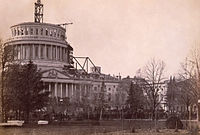United States Capitol
- A capital is a city that is home to a government. A capitol is a building where the legislature meets. For the capital of the United States, see Washington, D.C.
| United States Capitol | |
|---|---|
 The west face of the United States Capitol | |
 | |
| General information | |
| Architectural style | American Neoclassicism |
| Town or city | Capitol Hill, Washington, D.C. |
| Country | United States of America |
| Construction started | September 18, 1793 |
| Cost | (to build) $2 million |
| Technical details | |
| Size | 274 acres (1.11 km²) |
The United States Capitol is the building where the United States Congress meets. It is the center of the legislative branch of the U.S. federal government. It is in Washington, D.C., on top of Capitol Hill at the east end of the National Mall.
The capitol has a large dome in the center, above a rotunda—a large space that is shaped like a circle. There are two wings that are connected to the rotunda on opposite sides. The north wing is where the Senate meets and the south wing is where the House of Representatives meets. These wings are also called chambers. On the top floors of the chambers are galleries, or balconies where people can watch the Senate and House of Representatives from above.
The Statue of Freedom is on top of the capitol.
History
[change | change source]The Continental Congress first met in Philadelphia at Carpenter's Hall in 1774 and then at Independence Hall in 1776.[1] Congress convened in various cities during the Revolutionary War, and the Treaty of Paris was ratified in Annapolis, Maryland, in early 1784. Congress later moved to Trenton, New Jersey, and afterward to New York City.[1] There, Congress met in City Hall (Federal Hall) from 1785 to 1790.[2] When the capital was moved back to Philadelphia, Pennsylvania, from 1790 to 1800, the Philadelphia County Building (Congress Hall) became the capitol.[3] In 1800, the capital moved again to Washington, D.C., and a new capitol building was constructed.

The capitol was designed by William Thornton.[4] Construction started in 1793, but it was not completely finished until almost twenty years later. The Senate started to meet in the capitol in 1800, when the Senate wing was finished. The House started to meet in the capitol in 1807, even though the House wing was not finished until 1811.[5]
At that time, it was not as big as it is now. The dome in the center of the building was smaller and made of wood. In 1814, the capitol was set on fire by the British Army during the War of 1812.[6] In the 1850s and 1860s, the capitol was fully repaired, and the wooden dome was replaced with a larger iron dome.[7] The walls of the Senate wing were painted with many murals about events in American History. Inside the rotunda, a large fresco was also painted on the ceiling during the repair.
The Supreme Court also met in the Capitol until its own building was completed in 1935.[8]
The Capitol Dome is 8,909,200 pounds (4,009 tonnes) of cast-iron with 108 windows, and was constructed between 1855 and 1866.[9]
On January 6, 2021, supporters of US President Donald Trump stormed into the capitol. This caused a lockdown in the building.[10]
References
[change | change source]Citations
[change | change source]- ↑ 1.0 1.1 "8 Forgotten Early Capitals of the United States". HISTORY. October 4, 2023. Retrieved April 23, 2024.
- ↑ "History & Culture - Federal Hall National Memorial". NPS.gov. National Park Service. May 30, 2015. Archived from the original on July 10, 2019. Retrieved July 10, 2019.
- ↑ "Congress Hall - Independence National Historical Park". NPS.gov. National Park Service. August 25, 2017. Archived from the original on July 3, 2019. Retrieved July 10, 2019.
- ↑ The Editors of Encyclopaedia Britannica (July 20, 1998). "William Thornton - American Architect, Inventor, and Public Official". Britannica.com. Archived from the original on April 17, 2019. Retrieved July 10, 2019.
- ↑ "Capitol cornerstone is laid". History.com. A&E Television Networks. November 24, 2009. Archived from the original on July 10, 2019. Retrieved July 10, 2019.
- ↑ AOC Curator Office (August 22, 2012). "A Most Magnificent Ruin: The Burning of the Capitol during the War of 1812". AOC.gov. Architect of the Capitol. Archived from the original on May 15, 2019. Retrieved July 10, 2019.
- ↑ Glass, Andrew (May 1, 2017). "President Fillmore rules on Capitol expansion, May 1, 1851". Politico.com. Archived from the original on July 10, 2019. Retrieved July 10, 2019.
- ↑ "Homes of the Court". Supreme Court History.org. Supreme Court Historical Society. Archived from the original on March 27, 2019. Retrieved July 10, 2019.
- ↑ "US Capitol Fast Facts". CNN.com. September 30, 2013. Archived from the original on May 18, 2019. Retrieved September 1, 2017.
- ↑ Amanda Macias (January 6, 2021). "Rioters storm Capitol after Trump urges action, halting declaration of Biden victory". cnbc.com. CNBC. Retrieved January 6, 2021.
Books
[change | change source]- Reed, Henry Hope (2005). The United States Capitol: Its Architecture and Decoration (illustrated ed.). Norton. ISBN 0393038319.
- Allen, William Charles (2001). History of the United States Capitol: A Chronicle of Design, Construction, and Politics. Vol. 106 (illustrated ed.). U.S. Government Printing Office. ISBN 0160508304. OCLC 46420177.
- Maroon, Fred J.; Maroon, Suzy; Boorstin, Daniel Joseph (1993). The United States Capitol (illustrated ed.). Stewart, Tabori & Chang. ISBN 1556703163.
- Architect of the Capitol (1976). Art in the United States Capitol. U.S. Government Printing Office. OCLC 2181271.
- Aikman, Lonnelle; United States Capitol Historical Society; National Geographic Society (U.S.) (1963). We, the People: The Story of the United States Capitol, Its Past and Its Promise, Volume 62, Page 39 (2 ed.). United States Capitol Historical Society. ISBN 0916200140.
